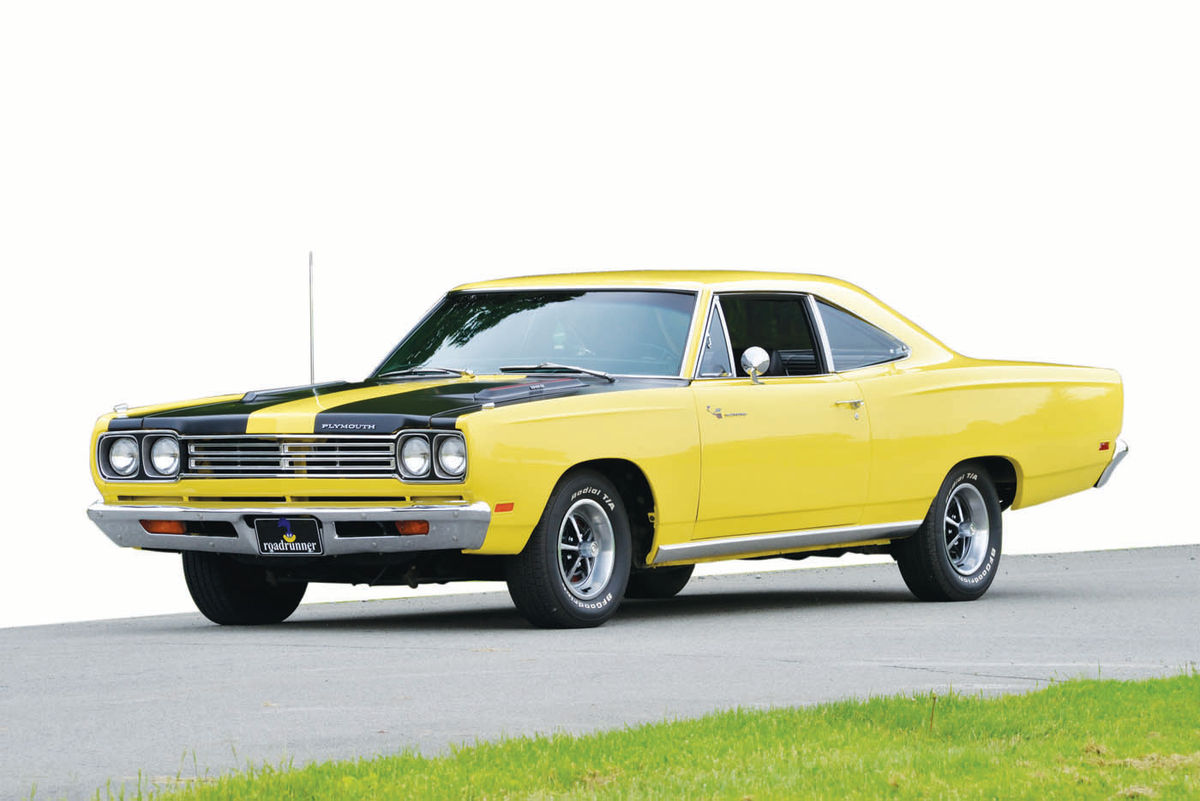1969 PLYMOUTH ROAD RUNNER
They Were Immediately Hooked on Mopar’s Muscular Bird, But This One Sure Has Presented Some Challenges Along the Way.
The trailer-ride across Pennsylvania for Joe and Lisa Bollard’s Road Runner eight years ago was the first leg of a trip marked by good luck, detours, interruptions and bad luck before the car reached the restored condition it’s in today
“We bought it in August of 2011,” Joe recalled. “I have a very good friend who I grew up with. He got into Mopars probably about 25 or 30 years ago. He had moved down to North Carolina and he wanted to meet up again, so he invited me to Carlisle for the Chrysler Nationals. Walking around, my wife decided that she wanted a Road Runner and that’s how it all started.
“I pursued it on the Internet, I looked and looked and we found one on eBay. It wasn’t very long. We were in Carlisle in July and we got the car in August.”
A Delayed Start In the V-8 Department
When the feature car was built in 1969, Plymouth’s late exit from the practical-carsonly market segment had already paid off.
In 1955 the division had been the last at Chrysler to receive a V-8 and even then was cheated. The corporation had introduced its 331-cubic-inch Hemi in 1951 and naturally placed it in the Chrysler as the FirePower V-8. DeSoto’s version of the Hemi, the Firedome, followed in 1953, as did Dodge’s Red Ram, but Plymouth went on for another year with its solidly reliable flathead six before adding the Hy-Fire V-8.
Unlike its relatives, however, the Hy-Fire wasn’t a Hemi, but used heads with polyspherical combustion chambers on a block derived from the Red Ram. That provided 157 horsepower from 241 cubic inches, but Plymouth couldn’t boast of having a Hemi. More painfully for Plymouth, Dodge’s 1955 base Red Ram was a 270 generating 175 horsepower and when properly optioned, it became the 193-horsepower Super Red Ram.
Responding With a Fury
Everyone had gone to V-8s and performance potential was being discussed even in polite company, so Plymouth let loose and for 1956 introduced its Fury with a 240-horsepower 303. It was a wonderful time to be a hardcore driver because the entire American auto industry was focused on the same target and Plymouth Had determined that it would not be left behind.
By 1958 Plymouth offered a 350 producing 305 horsepower and with the other Chrysler divisions, even tinkered with fuel-injection that unfortunately proved less than successful. Four years later, a 420-horsepower 413 was available and in 1964, Plymouth finally had its Hemi, a 426 rated at 425 horsepower.
At about the same time, performance cars as a group were about to change. Ford had tapped what had been a mostly underserved market by introducing the Mustang in the spring of 1964; just days after Plymouth Had launched its sporty Barracuda in the Valiant line. The competition followed and it wasn’t long before the old concept of a big engine in a smaller body was refined by boosting output in the mid-size models that were now appearing. At Plymouth in 1966, that translated to a 235-horsepower 273 in the Barracuda and the 426 in the Satellite.
Muscle on a Tighter Budget
If there was a downside to this new approach to performance, it was the one that had always been there, namely the cost. Performance cars from the earliest had not been cheap and they still weren’t, so Plymouth’s solution was the Road Runner.
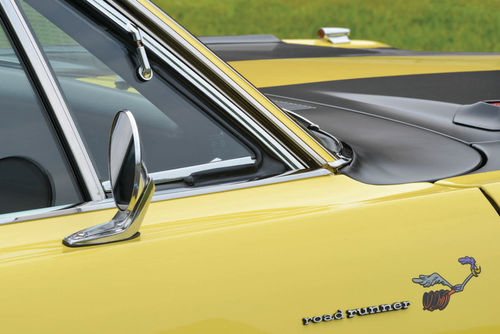
Based on the Satellite or Belvedere— as was the costlier GTX muscle car— Plymouth described it as “some other kind of bird” in an early advertisement. The Road Runner offered a dose of the division’s old-time practicality in a sense, as the ad explained that “although it looks like a hardtop, (it) is really a two-door coupe which makes for extra rigidity” and is “marked by an absence of exterior frills and ornamentation. Even the rear windows are simple swing-out units that offer additional savings in weight over roll-up units.” That was a pretty good hint at the philosophy behind the Road Runner, but the ad also spoke of the other critical point.
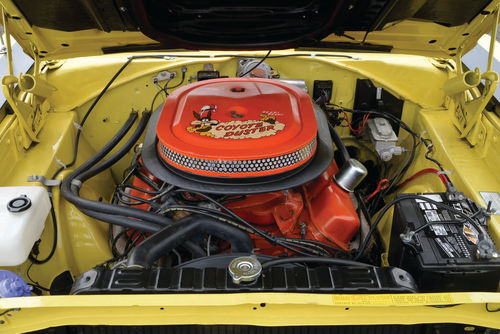
“The standard Road Runner powerplant,” it noted, “is an exclusive version of our 383-cubic-inch V-8. Heads are borrowed from the big 440-cubicinch GTX engine because of the massive intake and exhaust valves, 3.2-squareinch ports and stiffer valve springs. The cam, intake manifold, valve train and exhaust headers are likewise GTX in origin. Resultant compression is 10.1 to 1; horsepower is 335 at 5200 rpm; torque is 425 pounds-feet at 3400 rpm. Optional on all Road Runners is our 426 Street Hemi, which produces 425 horsepower at 5000 rpm and 490 pounds-feet of torque at 4000 rpm.”
For the Mopar fan or the driver who could be converted, it was an excellent argument and particularly so when combined with the price tag. The basic Road Runner coupe cost $2870 while the basic GTX hardtop cost $3329. Measured in today’s money—actually, 2018’s money, the most recent figures available—the two would now cost $20,664.99 and $23,969.95 respectively. Both were bargains, but the Road Runner was a real bargain and Plymouth was rewarded with more than 44,500 Road Runner sales and almost 19,000 for the GTX.
To no one’s surprise, the Road Runner continued for 1969 with improvements rather than radical changes. A convertible was now available and prices increased very slightly—the coupe was up by $70 from 1968—as Plymouth advertising told drivers that “if you want a high-performance car, Road Runner is one car to think about. Especially since Motor Trend named it Car of the Year. And MT had every car in the world to choose from. Surprising? Not when you consider this: The Road Runner is a real performer. But not because it costs a lot of money. It doesn’t.”
Impressive, but it wasn’t the ad copy, the specs, the style or even Motor Trend’s recognition that pushed the Bollards over the line.
They Went Browsing With a Friend…
“We went to Carlisle with Chas,” Lisa Bollard recalled. “Chas was always talking about his Road Runners. And when we went to Carlisle, I got the bug, came home, we went on the Internet and ‘I have to have that one.’”
“That one” is a coupe built with the base 383, TorqueFlite automatic and an interesting combination of optional and standard equipment.
“It came with the décor package,” Joe explained, “which was the higher-end interior, body side moldings, fendermounted turn signals. It originally had a vinyl roof and we decided not to put the vinyl roof back on the car, AM radio, heater, no AC, power steering, no power brakes.”
The Road Runner’s history is slightly sketchy, as he said that it apparently was in Canada before being traded at a General Motors dealership in the states. The next owner worked at that dealership, bought the car and planned to either restore it or race it and tore it down, but died before he could complete the project. It then went to his brother-inlaw, who soon lost interest in it.
A Bird In Pieces
Having seen photos of the Road Runner, the Bollards headed for Pittsburgh to make the deal. Once they arrived and saw the car, Joe said, it was in much worse condition than he’d expected, but the floors looked good and the numbers proved that it was indeed a disassembled Road Runner, so they “loaded it up in pieces” for the trip home to Kingsley in the opposite corner of the state.
“All the body parts were there,” Joe said. “He gave me not the original, but a date-coded 383 block to go with it, but the 440 (now in the car) was rebuilt and the trans was supposed to have been rebuilt. So that was a plus…
“It took at least a half-day to load this car on the trailer, the parts, making sure we got everything. I was worried about ‘do I have this trim piece for this car?’ ‘Where is this stuff?’ And he was looking around, too, because he didn’t know where this stuff was. He had stuff in the shed, stuff in the garage, stuff in the backyard, so we tried to get everything together because I didn’t feel like driving another 600 miles back and forth to get these things.”
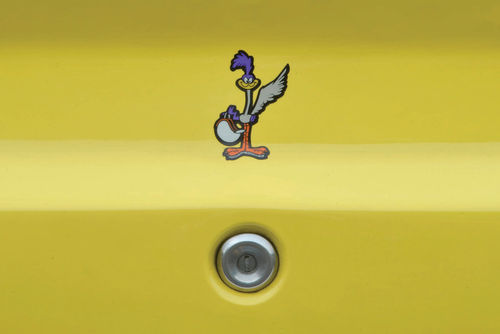
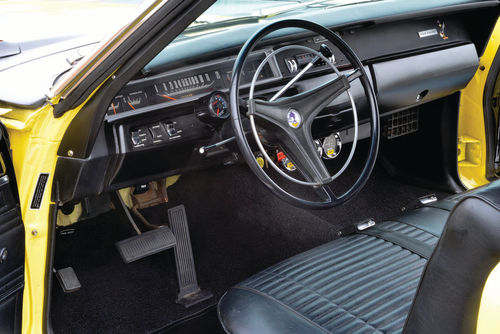
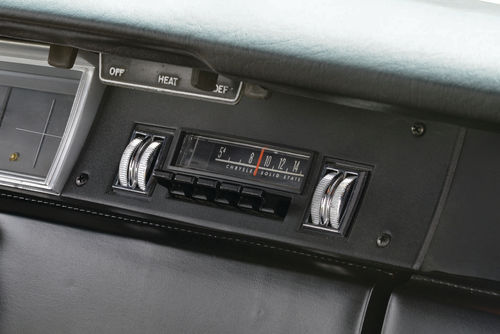
While they didn’t find every single piece, he said that nothing critical was missing, but that wasn’t the best news.
“We brought the car home,” Joe continued, “we took the car off the trailer and I said ‘let’s see whether this thing even runs.’ I got it to run within a couple of hours and I called him and said ‘it runs.’
“He was actually kind of surprised.”
The timing was right, as Joe was on vacation and had the time to get it running fairly well and load it back onto the trailer for a trip to New Jersey, where he works as a mechanic. Once there, the Road Runner went onto a lift so that he could give it a critical inspection and the result once again appeared to be in the plus column.
“Everything looked good,” Joe said. “A friend I’ve known for years owns a very well-known body shop. He came up and looked at it and he said ‘doesn’t look like a bad restoration (project).’ We took it right down there and that’s when it started. I gave him a deposit and he didn’t get onto the car right away, but maybe three weeks to a month and he started to get into it. And that’s when we found that more or less the back of the car had been covered with (filler)—the trunk gutters, the Dutch panel, the tops of the quarters, the taillight housings—but the rest of the car was pretty much intact.”
Good News to Balance the Problems
Realistically, it’s all but impossible to determine what had happened to the Road Runner, but he agreed that it might have been hit squarely in the rear, exposed to serious winter road salt and poorly washed or parked in a garage or under a cover that was too small, leaving the rear section exposed to the weather. In the latter situation, he said, water could have made its way in around the backlight and never found its way out until it rusted its own holes.
“It was rot,” Joe said. “The weather, the salt, whatever it was back in the day, it was rot, but they had covered it with (filler), primed it and painted it a little bit. It looked kind of nice until you’d take that off and find out what you’ve got.”
It was an unexpected headache, but not a complete nightmare. Joe said the roof panel beneath the vinyl was so good that his friend who was handling the bodywork said it was one of the best he’d ever seen on a Mopar of that era. The quarter panels, too, and a considerable percentage of the rear clip didn’t rise to the level of a full-blown horror story.
“The quarters were good,” Joe said. “It looked like they’d been replaced at one time, but the top of the quarter on the right side, the trunk gutters, near the window and the panel below the window (were damaged), so that’s where it started. The wheelhousings were good, the trunk had only one patch put on it years ago and it was done right, which is remarkable, but the wheelhousings were all there. Up where the back seat is, that was all intact.”
That does seem to point to poor storage more than anything else, but then again…
“When he took the right-side quarter panel off,” Joe explained, “he did find out that the wheelhousing had a little ding in it, that it was hit on the right side at one time.”
Finding More to Smile About
No matter where the problems began, they weren’t fatal to the restoration and he said that with his blessing, the shop handled the Road Runner whenever it fit between other work. It was an arrangement that gave Joe time, too, so he was to take the doors, hood, decklid and fenders back to Pennsylvania where a local shop media-blasted every piece. As that was going on, he ordered new parts to replace those deemed not good enough and had them shipped to the body shop, but while the Road Runner was in pieces, close looks at the shell in New Jersey and the sheet metal in Pennsylvania provided further good news.
“The cowl was good,” Joe said. “The firewall was good and that was another thing that rotted out in those cars. Believe it or not, the car had the original rockers on it and it still has the original rockers on it. Very little rust on the bottoms of the fenders, none on the top, so that was a plus. And the holes were still there for the turn signals so we knew exactly where they went.
“The door hinges were good. There was no sag in the hinges, no sag in the hood hinges. The hood was good. There was a little warpage, but he resealed it together and straightened it out. The grille and headlight bezels are all original to the car. The front bumper is; the rear bumper is not. The rear bumper is a reconditioned bumper.”
It’s Back on the Road, But Then…
Once the body was complete, the Road Runner was assembled and primed, blocksanded, primered again and disassembled. The panels were then painted individually and the car was reassembled in May of 2017 and reinstalling the glass, trim and interior began at once in the shop where Joe works. The factory wheels that had been on the car were stripped and repainted, and their trim rings were polished. Joe said that by July, it again looked like a car and he had a plan.
“I was going to drive up about 85 miles,” he said, “and surprise Lisa. We were going to do some work when I got home. She was waiting and waiting and I got about halfway home and I could see a little bit of smoke coming out of the back of the car. I pulled over and the trans was leaking a little bit. It was supposedly rebuilt. Not a problem, probably just dried up, so I got a little bit of Lucas, a quart of trans fluid and by the time I got maybe three-quarters of the way home, it stopped (smoking), so I was happy.
“Then I heard a rod knock. I got off the exit and I said ‘this can’t be happening.’”
“And I could hear him coming,” said Lisa. “I could hear the car coming on our road. I heard it and I said ‘oh, no.’ My heart was breaking. It was ‘ooooooh, noooooo. She’s blowing up.’ I actually heard it and my heart just sank.”
“He pulled it in and he said ‘sorry.’”
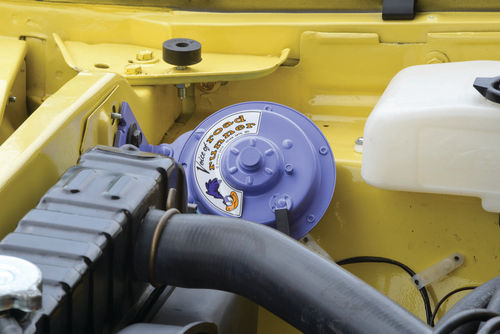
In Need of a Rebuild
The 440 might have been rebuilt by some previous owner, but it now needed help again and so the Road Runner was taken back to New Jersey. Joe pulled the engine and transmission, went through the transmission to minimize the chance of another unfortunate surprise and then tore the 440 down.
“The motor came all apart,” he said, “crankshaft, rods, pistons, gaskets, heads. It had spun one bearing right off. Right off.”
He contracted the machine work such as grinding the crankshaft and handled the actual rebuild himself. He found that the bearings were stamped “1984,” meaning they were replacements, and before reinstalling the engine and transmission, he further detailed the engine compartment and subframe. It all went back together and he soon realized that the car was geared lower than he’d hoped, so the 3.91 rear end gears were replaced with 3.55s.
“We were fine,” Joe said. “There were no more surprises with the drivetrain. The drivetrain was good now. We were back in Pennsylvania. The car was actually home. It had a home, now we could do more detail work on it, clean it up, finish what we had to finish. The door panels were going in, headliner, visors. We got the rugs into it, the sound deadener, we put the seats in, bolted everything down for the final time. That’s about it and now we were basically almost ready for the shows.”
Things Were Looking Up, Until…
The Road Runner went to its first show early in 2018 and won a trophy. The Bollards were looking forward to the next event, which should have been the start of years of enjoyment, but it didn’t quite work out that way.
“May 2018,” Joe said, “I’m at work and the car is outside, two covers on it, but we left it outside. I don’t remember whether we were going someplace, but a hailstorm came through Kingsley. She called, screaming, and I said ‘can you move the car?’ She said ‘if I go outside, I’m dead. The hail is like baseballs.’”
The cost to repair the damage to the Road Runner topped the cost of fixing either their Honda or their Ram and approached the bill for their house’s repairs. The Road Runner’s insurance carrier covered the damage without any hesitation, but Joe’s reaction was about what would be expected.
“The thing that was going through my mind,” he said, “was ‘what’s going to happen? What are we going to do to it? Is this going to be another whole body job? Does the car have to be stripped? Is it going to have fillers with all of these dents in it?’ The body guy was telling me that the whole car might have to be stripped and painted. ‘I don’t know if I can get them out. Let me call this paintless dent guy I deal with and see what he says.’ The kid looked at it. ‘Those are deep, but I’ll try’ and he didn’t even mark the paint.
“Say he was going to start on the decklid. He’d have a light and he’d have spoons because he had to go down between the pinch welds. No hammer, he worked from the outside to the inside, just pushing, pushing, pushing. He had all different spoons, long ones, short ones. The kid is amazing. One dent might take him a half-hour, an hour, an hour-and-a-half.”
After about a month of work, the Road Runner was again perfect and its streak of bad luck was over, but not forgotten.
“I’d started to believe him,” Lisa confessed, “that maybe it was the dead man who didn’t want us to have the car.”
“That went over in my mind 100 times,” Joe said. “Here I am, working on this thing, and I move my head and the fender slices my forehead. The guy I was working with was looking at me. ‘What the hell is wrong with that car?’ ‘Christine.’
“The motor blows. Everything’s wrong. The motor was the last thing on my mind. I must’ve started that car 100 times, in and out of the garage, down the road, to the body shop.”
Part of the Family
The hailstorm might have been the last disaster, but they’re taking no chances.
“It never stays anywhere but in that garage,” Joe said.
“I don’t leave that car,” Lisa added.
And with its purely random—but still slightly unnerving—run of minor and major problems apparently ended, the Road Runner’s future is assured. The car isn’t going anywhere and that’s not just because of what it is or because of the undeniable fun of owning it and driving it.
“I’m not a materialistic person at all,” Lisa observed. “It’s because of him, what he did to it for me.”

